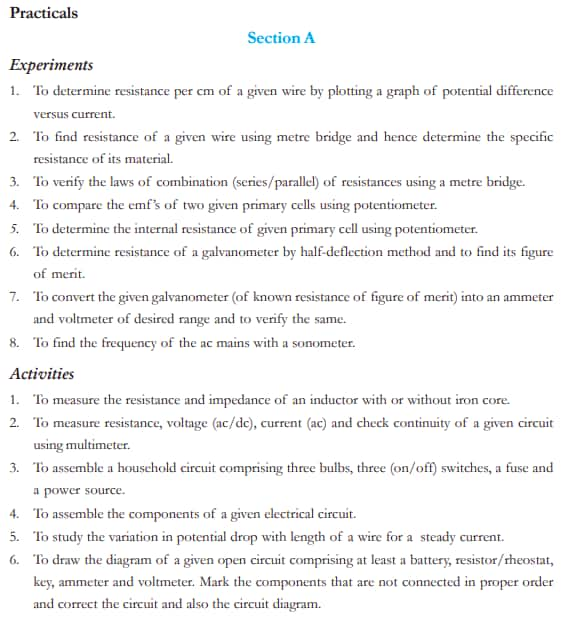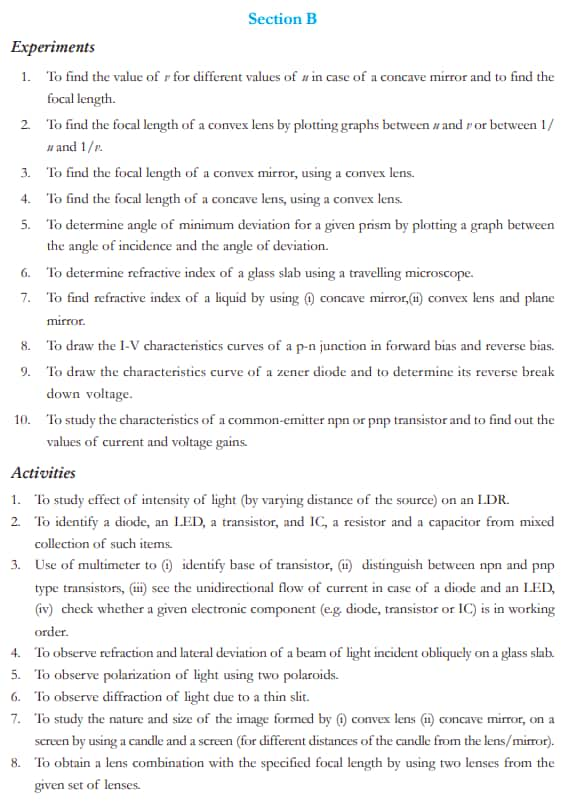MP Board Class 12 Physics Syllabus 2026 (Out): Check Topics, Chapter List & Exam Pattern
MP Board 12th Exam Date:07 Feb' 26 - 07 Feb' 26
The Madhya Pradesh Board of Secondary Education releases the MP Board Class 12 Physics syllabus 2026. The board prescribed 10 chapters for the MP Board 12th syllabus 2025-26 physics subject. The MPBSE 12th Class physics will have 40% objective, 40% subjective, and 20% analytical question types. Students can visit the official website at mpbse.nic.in to view and download the MP Board 12th Physics 2026 syllabus.
This Story also Contains
- MP Board 12th Class 2026 Physics Syllabus: Unit-Wise
- Detailed MP Board Class 12 Physics 2026 Syllabus
- MP Board Class 12 Physics Practical Exam Syllabus 2026
.jpg)
Candidates are advised to go through the MP Board 12th exam pattern to understand the marking scheme and start preparing for the board exam accordingly. They must ideate strategies to cover the MP board 12th Class 2026 physics syllabus topic-wise. Read the article to learn more about the MP Board Class 12 Physics syllabus 2026.
Overview of MP Board Class 12 Syllabus 2026 Physics
Particulars | Details |
Total chapters | 10 chapters |
Question types |
|
Theory marks | 70 marks |
Practical marks | 30 marks |
Total marks | 100 marks |
MP Board 12th Class 2026 Physics Syllabus: Unit-Wise
Units | Chapters |
Unit 1 | Electrostatics |
Unit 2 | Current Electricity |
Unit 3 | Magnetic Effects of Current and Magnetism |
Unit 4 | Electromagnetic induction and alternating current |
Unit 5 | Electromagnetic Waves |
Unit 6 | Optics |
Unit 7 | Dual nature of matter and radiation |
Unit 8 | Atoms and nuclei |
Unit 9 | Electronic Devices |
Unit 10 | Communication Systems |
Detailed MP Board Class 12 Physics 2026 Syllabus
Students who want to appear for the MP Board 12th examination must go through all 10 chapters given below to prepare well for the board exam. They must go through every chapter topic-wise to understand the concept well. Check out the sections below to learn more about the MPBSE 12th Physics syllabus 2026 in detail.
Unit I: Electrostatics
Electric charges and their conservation. Coulomb’s law – force between two point charges, forces between multiple charges; superposition principle and continuous charge distribution.
Electric field, electric field due to a point charge, electric field lines; electric dipole, electric field due to a dipole; torque on a dipole in a uniform electric field.
Electric flux, statement of Gauss’s theorem and its applications to find the field due to an infinitely long straight wire, a uniformly charged infinite plane sheet and a uniformly charged thin spherical shell (field inside and outside).
Electric potential, potential difference, electric potential due to a point charge, a dipole and a system of charges; equipotential surfaces, electrical potential energy of a system of two point charges and electric dipoles in an electrostatic field.
Conductors and insulators, free charges and bound charges inside a conductor. Dielectrics and electric polarisation, capacitors and capacitance, combination of capacitors in series and parallel, capacitance of a parallel plate capacitor with and without dielectric medium between the plates, energy stored in a capacitor, Van de Graaff generator.
Unit II: Current Electricity
Electric current, flow of electric charges in a metallic conductor, drift velocity and mobility, and their relation with electric current;
Ohm’s law, electrical resistance, V-I characteristics (linear and non-linear), electrical energy and power, electrical resistivity and conductivity.
Carbon resistors, colour code for carbon resistors; series and parallel combinations of resistors; temperature dependence of resistance.
Internal resistance of a cell, potential difference and emf of a cell, combination of cells in series and parallel.
Kirchhoff’s laws and simple applications. Wheatstone bridge, metre bridge.
Potentiometer – principle and applications to measure potential difference, and for comparing the emf of two cells; measurement of internal resistance of a cell.
Unit III: Magnetic Effects of Current and Magnetism
Concept of magnetic field, Oersted’s experiment.
Biot-Savart law and its application to a current-carrying circular loop.
Ampere’s law and its applications to infinitely long straight wire, straight and toroidal solenoids. Force on a moving charge in uniform magnetic and electric fields. Cyclotron.
Force on a current-carrying conductor in a uniform magnetic field. Force between two parallel current-carrying conductors – definition of ampere. Torque experienced by a current loop in a magnetic field; moving coil galvanometer – its current sensitivity and conversion to ammeter and voltmeter.
Current loop as a magnetic dipole and its magnetic dipole moment. Magnetic dipole moment of a revolving electron. Magnetic field intensity due to a magnetic dipole (bar magnet) along its axis and perpendicular to its axis.
Torque on a magnetic dipole (bar magnet) in a uniform magnetic field; bar magnet as an equivalent solenoid, magnetic field lines;
Earth’s magnetic field and magnetic elements. Para-, dia- and ferro-magnetic substances, with examples. Electromagnets and factors affecting their strengths. Permanent magnets.
Unit IV: Electromagnetic Induction and Alternating Currents
Electromagnetic induction; Faraday’s law, induced emf and current; Lenz’s Law, Eddy currents. Self and mutual inductance.
Need for displacement current.
Alternating currents, peak and rms value of alternating current /voltage; reactance and impedance; LC oscillations (qualitative treatment only), LCR series circuit, resonance; power in AC circuits, wattless current.
AC generator and transformer.
Unit V: Electromagnetic Waves
Electromagnetic waves and their characteristics (qualitative ideas only). Transverse nature of electromagnetic waves.
Electromagnetic spectrum (radio waves, microwaves, infrared, visible, ultraviolet, x-rays, gamma rays), including elementary facts about their uses.
Unit VI: Optics
Reflection of light, spherical mirrors, mirror formula. Refraction of light, total internal reflection and its applications, optical fibres, refraction at spherical surfaces, lenses, thin lens formula, lens-maker’s formula. Magnification, power of a lens, combination of thin lenses in contact. Refraction and dispersion of light through a prism.
Scattering of light – blue colour of the sky and reddish appearance of the sun at sunrise and sunset.
Optical instruments: Human eye, image formation and accommodation, correction of eye defects (myopia, hypermetropia, presbyopia and astigmatism) using lenses. Microscopes and astronomical telescopes (reflecting and refracting) and their magnifying powers.
Wave optics: Wavefront and Huygens’ principle, reflection and refraction of a plane wave at a plane surface using wavefronts. Proof of laws of reflection and refraction using Huygens’ principle. Interference, Young’s double slit experiment and expression for fringe width, coherent sources and sustained interference of light.
Diffraction due to a single slit, the width of the central maximum. Resolving power of microscopes and astronomical telescopes. Polarisation, plane polarised light; Brewster’s law, uses of plane polarised light and Polaroids.
Unit VII: Dual Nature of Matter and Radiation
Photoelectric effect, Hertz and Lenard’s observations; Einstein’s photoelectric equation – particle nature of light.
Matter waves – wave nature of particles, de Broglie relation. Davisson-Germer experiment.
Unit VIII: Atoms and Nuclei
Alpha-particle scattering experiment; Rutherford’s model of the atom; Bohr model, energy levels, hydrogen spectrum.
Composition and size of nucleus, atomic masses, isotopes, isobars, isotones. Radioactivity – alpha, beta and gamma particles/rays and their properties; radioactive decay law. Mass-energy relation, mass defect, binding energy per nucleon and its variation with mass number; nuclear fission and fusion.
Unit IX: Electronic Devices
Semiconductors: semiconductor diode – I-V characteristics in forward and reverse bias, diode as a rectifier; I-V characteristics of LED, photodiode, solar cell, and Zener diode; Zener diode as a voltage regulator.
Junction transistor, transistor action, characteristics of a transistor; transistor as an amplifier (common emitter configuration) and oscillator. Logic gates (OR, AND, NOT, NAND and NOR). The transistor is a switch.
Unit X: Communication Systems
Elements of a communication system (block diagram only); bandwidth of signals (speech, TV and digital data); bandwidth of transmission medium.
Propagation of electromagnetic waves in the atmosphere, sky and space wave propagation. Need for modulation. Production and detection of an amplitude-modulated wave.
MP Board Class 12 Physics Practical Exam Syllabus 2026
The MPBSE Board has prescribed the MP Board 12th Class practical exam syllabus for physics in two sections. Students can check out the topics given in both sections to understand the practical examination better.
MP Board 12th Class Physics Practical Syllabus for Section A

MP Board Class 12 Practical Exam Syllabus for Section B

Questions related to MP Board 12th
On Question asked by student community
The MP Board Class 12 Hindi Model Paper (2026) is your essential resource for exam preparation! You can find and download these model papers directly from the Careers360 page whose link is https://school.careers360.com/hi/articles/mp-board-12th-model-papers to familiarize yourself with the official exam pattern, question format, and marking scheme set by the Madhya Pradesh Board. Consistent practice with these papers is the best strategy for securing high scores in the final exam
Hello,
You can get the MP Board Class 12 Hindi 2025-26 Model Papers from the Careers360 website. Practising these papers will helps you to understand the exam pattern, to identify the important topics, to improve time management, and overall it enhances your exam preparation.
LINK: https://school.careers360.com/hi/articles/mp-board-12th-model-papers
Hope it helps!
Hello,
You can get the MP Board Class 12 Previous year papers from the Careers360 website. Practising these papers will helps you to understand the exam pattern, to identify the important topics, to improve time manahgement, and overall it enhances your exam preparation.
LINK: https://school.careers360.com/boards/mp-board-previous-year-question-paper-class-12-solutions-pdf
I hope this answer helps you!
Hello
https://school.careers360.com/boards/mp-board-previous-year-question-paper-class-12-solutions-pdf
Just visit the link I have attached above. It will help you with all the related information and you can practice the previous year question with answer and it makes you more confident.
Hello,
As you are asking for MP board syllabus of class 12 I've provided you a link from this you can download your resources eg., Syllabus and you can also check syllabus
https://school.careers360.com/boards/mpbse/mp-board-12th-syllabus
I hope this helps you
Thank you
Applications for Admissions are open.
As per latest syllabus. Physics formulas, equations, & laws of class 11 & 12th chapters
JEE Main Important Chemistry formulas
Get nowAs per latest syllabus. Chemistry formulas, equations, & laws of class 11 & 12th chapters
JEE Main high scoring chapters and topics
Get nowAs per latest 2024 syllabus. Study 40% syllabus and score upto 100% marks in JEE
JEE Main Important Mathematics Formulas
Get nowAs per latest syllabus. Maths formulas, equations, & theorems of class 11 & 12th chapters
